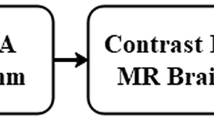Abstract
A three-dimensional representation of vasculature can be extremely important in image-guided neurosurgery, pre-surgical planning. In this paper, a spatial continuity incorporated multi-attribute fuzzy clustering algorithm (MAFCM_S) is proposed to segment entire blood vessels from TOF MRA images. This clustering method takes both the intensity information and the geometrical information into account, while most of the current clustering methods only deal with the former. In this method, a new dissimilarity measure, which integrates the intensity and the geometry shape dissimilarity, is introduced. Because of the presence of the geometrical information, the new measure is able to differentiate the pixels with similar intensity values within different geometrical shape structures. Experimental results show that the new algorithm can get better segmentation.
Similar content being viewed by others
References
Kirbas C, Quek F. Vessel extraction techniques and algorithms: a survey. In: Proceedings of the 3rd IEEE Symposium on BioInformatics and BioEngineering. Bethesda, Maryland, 2003. 238–245
Suri J S, Liu K, Reden L, et al. A review on MR vascular image processing: skeleton versus nonskeleton approaches: Part II. IEEE Trans Inf Tech Biomed, 2002, 6: 338–350
Frangi A, Niessen W, Vincken K, et al. Multiscale vessel enhancement filtering. In: Proceedings of the Interantional Conference on Medical Image Computing Computerassisted Intervention. Lect Notes Comp, 1998, 1496: 130–137
Sato Y, Nakajima S, Shiraga N, et al. Three-dimensional multi-scale line filter for segmentation and visualization of curvilinear structures in medical images. Med Image Anal, 1993, 2: 143–168
Krissian K, Malandain G, Ayache N, et al. Model based multiscale detection of 3D vessels. In: Proceedings of the Interantional Conference on Computer Vision and Pattern Recognition (CVPR). Santa Barbara, CA, USA, 1998. 722–727
Lorigo L M, Faugeras O D, Grimson W E L, et al. CURVES: curve evolution for vessel segmentation. Med Image Anal, 2001, 5: 195–206
Vasilevskiy A, Siddiqi K. Flux-maximizing geometric flows. IEEE Trans Patt Anal Mach Intell, 2002, 24: 1565–1578
Delphine N, Anthony Y, Greg T. Vessel segmentation using a shape driven flow. In: Proceedings of the Medical Image Computing and Computer-Assisted Intervention (MICCAI), LNCS 3216, St. Malo, France, 2004. 51–59
Hassouna M S, Farag A A, Hushek S, et al. Cerebrovascular segmentation from TOF using stochastic models. Med Image Anal, 2006, 10: 1–18
Wilson D L, Noble J A. An adaptive segmentation algorithm for time-of-flight MRA data. IEEE Trans Med Imag, 1999, 18: 938–945
Chung A, Noble J A. Statistical 3D vessel segmentation using a Rician distribution. In: Proceedings of the International Conference on Medical Image Computing Computer-assisted Intervention. Lect Notes Comp, 1999, 1679: 82–89
Wong W C K, Chung A C S. Bayesian image segmentation using local iso-intensity structural orientation. IEEE Trans Image Process, 2005, 14: 1512–1523
Bezdek J C, Hall L O, Clarke L P. Review of MR image segmentation techniques using pattern recognition. Med Phys, 1993, 20: 1033–1048
Pham D L, Prince J L, Dagher A P, et al. An automated technique for statistical characterization of brain tissues in magnetic resonance imaging. Int J Patt Recognit Artificial Intell, 1997, 11: 1189–1211
Liew A W C, Leung S H, Lau W H. Fuzzy image clustering incorporating spatial continuity. Inst Elec Eng Vis Image Signal Process, 2000, 147: 185–192
Pham D L. Spatial models for fuzzy clustering. Comput Vision Image Understand, 2001, 84: 285–297
Author information
Authors and Affiliations
Corresponding author
Rights and permissions
About this article
Cite this article
Hao, J., Zhao, J. & Li, M. Spatial continuity incorporated multi-attribute fuzzy clustering algorithm for blood vessels segmentation. Sci. China Inf. Sci. 53, 752–759 (2010). https://doi.org/10.1007/s11432-010-0072-2
Received:
Accepted:
Published:
Issue Date:
DOI: https://doi.org/10.1007/s11432-010-0072-2




